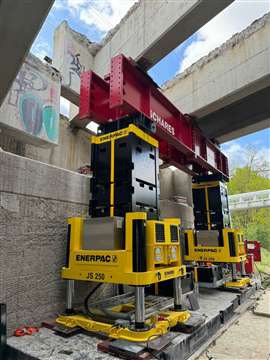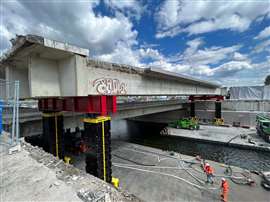Troubled bridges: disposing of Berlin’s Marggraff Bridge
13 September 2024
Like thousands of bridges across Europe, Berlin’s Marggraff Bridge, a 60 metre-long 1960s-built concrete structure, was suffering from age and deterioration. Lucy Barnard reports on how German heavy lift contractor Autokrane Schares used a system of automated hydraulic jacks to safely remove it.
For a fairly non-descript motorway bridge over a canal in Berlin’s southeastern suburbs, Marggraff Bridge, a 60 metre-long concrete structure over the Berlin’s Britz Canal stands not just as a microcosm of German history over the last one hundred years but a symbol of Europe’s growing infrastructure problems.
In the 2010s routine inspections revealed that the bridge was more dilapidated than originally envisaged and much of its’s prestressed concrete structure was riddled with concrete cancer – a condition where the Communist-era reinforced concrete structure had reacted with chemicals in the environment and decayed.
 Positioning the Enerpac JS-250 under the bridge deck. Photo: Schares
Positioning the Enerpac JS-250 under the bridge deck. Photo: Schares
Finally, in 2015, the Waterways and Shipping Administration, which is in charge of maintaining the safety of the bridge took the decision to remove Marggraffbrűcke and replace it with a safer, more modern alternative.
For German heavy lift contractor Autokrane Schares, the company charged with removing the 1965-built Marggraffbrűcke, the key difficulty was lifting the 1,500 tonne, 60 metre long span just metres away from a busy road intersection and in an area festooned with overhead power lines while a single track railway tunnel and high voltage line ran parallel to the bank beneath the southern bridge.
Challenges
“Space restrictions at the site made this a very challenging project,” said Max Boere, team leader SPMT, Autokrane Schares.
And Marggraffbrűcke is just one of thousands of 1950s and 1960s built concrete and steel structures across Europe which engineers estimate are in urgent need of replacement as ageing reinforced concrete reacts with pollution, especially carbon dioxide, triggering corrosion.
In April, Christian Tridon, founder of the Eurobridge conference told delegates that in his opinion, a tenth of Europe’s approximately two million bridges are in a potentially dangerous condition.
But how do construction teams go about safely removing these huge legacy structures which are located on busy thoroughfares and often in densely populated city centres?
For Schares and other European lifting companies, the situation is likely to lead to an increase in major bridge removals, often requiring specialist hydraulic equipment.
To safely remove the Marggraffbrűcke, Boere and his team opted to use a hi-tech automated lifting system produced by US-quoted high-pressure hydraulic equipment company, Enerpac, which stacks together specially designed steel barrels to incrementally lift heavy and unusual loads.
JS-250 jack-up system
The Marggraffbrűcke in fact comprised three superstructures which were supported by box abutments with flat foundations on the bank of the canal.
To safely take these apart, the team first used cutting equipment to remove a section of the bridge deck at each end of the structure, allowing them to lower the JS-250 jack-up tower bases and header beams on to the narrow canal tow path below. These were extended to support two of the corners of the load.
Next, the team floated two pontoons in the canal directly underneath the bridge on which more towers of jack-bases were positioned until the remaining two corners of the load were supported.
Finally, using two interconnected split flow pumps designed to move uneven loads uniformly, a single machine operator was able to simultaneously raise each of the portions of bridge deck three meters clear of the bridge abutments while the jack-up’s synchronous technology maintained the balance of the load.
 The bridge deck lifted clear of the abutments using the Enerpac JS-250 jack-up system. Photo: Schares
The bridge deck lifted clear of the abutments using the Enerpac JS-250 jack-up system. Photo: Schares
Once free of the abutments, the 60 metre reinforced concrete bridge sections were then moved laterally and slowly lowered onto steel frames resting on support structures. From there the sections were then floated to the side of the canal and lowered onto self-propelled modular transporter (SPMT) which then transported them by road to a nearby site for dismantling.
It took the Schares team two weeks to remove the three bridge sections, each weighing between 450 and 630 tonnes, using this system.
“The compactness and ease of set-up, together with accurate synchronised lifting, made the Enerpac JS-250 a perfect fit for this project,” Boere added.
A first road bridge on the site, built under the Weimar Republic and named after Arnold Marggraf, one of the men responsible for establishing the Berlin sewerage system, was constructed in 1930, in time for the 1936 Berlin Olympic Games.
Demolition of the first Marggraffbrűcke was far more dramatic. That bridge was severely damaged when it was blown up at the end of the Second World War by the Nazis in order to delay the advance of the Red Army into Berlin city centre.
STAY CONNECTED



Receive the information you need when you need it through our world-leading magazines, newsletters and daily briefings.
CONNECT WITH THE TEAM












